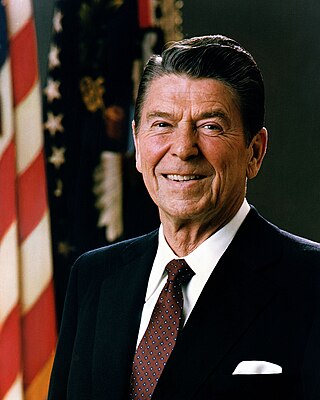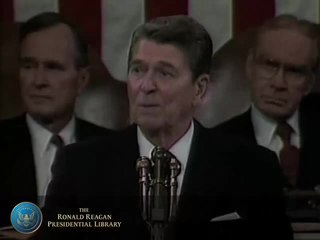
George Herbert Walker Bush was an American politician, diplomat, and businessman who served as the 41st president of the United States from 1989 to 1993. A member of the Republican Party, he also served as the 43rd vice president from 1981 to 1989 under Ronald Reagan, and in various other federal positions prior to that.

The State of the Union Address is an annual message delivered by the president of the United States to a joint session of the United States Congress near the beginning of most calendar years on the current condition of the nation. The State of the Union Address generally includes reports on the nation's budget, economy, news, agenda, progress, achievements and the president's priorities and legislative proposals.

Ronald Reagan's tenure as the 40th president of the United States began with his first inauguration on January 20, 1981, and ended on January 20, 1989. Reagan, a Republican from California, took office following a landslide victory over Democratic incumbent President Jimmy Carter in the 1980 presidential election. Four years later, in the 1984 election, he defeated Democrat former vice president Walter Mondale to win re-election in a larger landslide. Reagan was succeeded by his vice president, George H. W. Bush. Reagan's 1980 election resulted from a dramatic conservative shift to the right in American politics, including a loss of confidence in liberal, New Deal, and Great Society programs and priorities that had dominated the national agenda since the 1930s.

George H. W. Bush's tenure as the 41st president of the United States began with his inauguration on January 20, 1989, and ended on January 20, 1993. Bush was a Republican from Texas and the incumbent vice president for two terms under president Ronald Reagan. Bush took office following a victory over Democrat nominee Michael Dukakis in the 1988 presidential election. His presidency ended following his defeat in the 1992 presidential election by Democrat Bill Clinton. Bush was the father of the 43rd president, George W. Bush.

SAM 27000 was the second of two Boeing VC-137C United States Air Force aircraft that were specifically configured and maintained for the use of the president of the United States. It used the call sign Air Force One when the president was on board, and at other times it used the call sign SAM 27000, with SAM indicating 'Special Air Mission.' The VC-137C serial number 72-7000 was a customized version of the Boeing 707 which entered service during the Nixon administration in 1972. It served all US presidents until George W. Bush and was retired in 2001. It is now on display at the Ronald Reagan Presidential Library.

The weekly address of the president of the United States is the weekly speech by the president of the United States to the nation. Franklin D. Roosevelt was the first U.S. president to deliver such radio addresses. Ronald Reagan revived the practice of delivering a weekly Saturday radio broadcast in 1982, and his successors all continued the practice until Donald Trump ceased doing so seventeen months into his term.

The 1988 State of the Union Address was given by the 40th president of the United States, Ronald Reagan, on January 25, 1988, at 9:00 p.m. EST, in the chamber of the United States House of Representatives to the 100th United States Congress. It was Reagan's seventh and final State of the Union Address and his eighth and final speech to a joint session of the United States Congress. Presiding over this joint session was the House speaker, Jim Wright, accompanied by George H. W. Bush, the vice president.

The Reagan era or Age of Reagan is a periodization of recent American history used by historians and political observers to emphasize that the conservative "Reagan Revolution" led by President Ronald Reagan in domestic and foreign policy had a lasting impact. It overlaps with what political scientists call the Sixth Party System. Definitions of the Reagan era universally include the 1980s, while more extensive definitions may also include the late 1970s, the 1990s, the 2000s, the 2010s, and even the 2020s. In his 2008 book, The Age of Reagan: A History, 1974–2008, historian and journalist Sean Wilentz argues that Reagan dominated this stretch of American history in the same way that Franklin D. Roosevelt and his New Deal legacy dominated the four decades that preceded it.

The 1985 State of the Union Address was given by the 40th president of the United States, Ronald Reagan, on February 6, 1985 — Reagan’s 74th birthday — at 9:00 p.m. EST, in the chamber of the United States House of Representatives to the 99th United States Congress. It was Reagan's fourth State of the Union Address and his fifth speech to a joint session of the United States Congress. Presiding over this joint session was the House speaker, Tip O'Neill, accompanied by George H. W. Bush, the vice president.

The 1987 State of the Union Address was given by the 40th president of the United States, Ronald Reagan, on January 27, 1987, at 9:00 p.m. EST, in the chamber of the United States House of Representatives to the 100th United States Congress. It was Reagan's sixth State of the Union Address and his seventh speech to a joint session of the United States Congress. Presiding over this joint session was the House speaker, Jim Wright, accompanied by George H. W. Bush, the vice president.
The presidency of Ronald Reagan began on January 20, 1981, when Ronald Reagan was inaugurated as the 40th president of the United States, and ended on January 20, 1989.
George H. W. Bush, whose term as president lasted from 1989 until 1993, had extensive experience with US foreign policy. Unlike his predecessor, Ronald Reagan, he downplayed vision and emphasized caution and careful management. He had quietly disagreed with many of Reagan's foreign policy decisions and tried to build his own policies. His main foreign policy advisors were Secretaries of State James Baker, a longtime friend, and National Security Advisor Brent Scowcroft. Key geopolitical events that occurred during Bush's presidency were:
The following is a timeline of the presidency of George W. Bush, from January 1, 2004 to December 31, 2004.
The following is a timeline of the presidency of George W. Bush, from January 1, 2008 to January 20, 2009.
The following is a timeline of the presidency of George H. W. Bush, from January 1, 1991 to December 31, 1991.
The following is a timeline of the presidency of Bill Clinton, from January 1, 1996, to December 31, 1996.
The following is a timeline of the presidency of George H. W. Bush, from January 1, 1990 to December 31, 1990.
The following is a timeline of the presidency of Bill Clinton, from January 1, 2000 to January 20, 2001.
The following is a timeline of the presidency of Ronald Reagan from January 1, 1987, to December 31, 1987.
The following is a timeline of the presidency of Richard Nixon from January 1, 1974, to August 9, 1974, when, in the face of almost certain impeachment and removal from office, he resigned the presidency.










